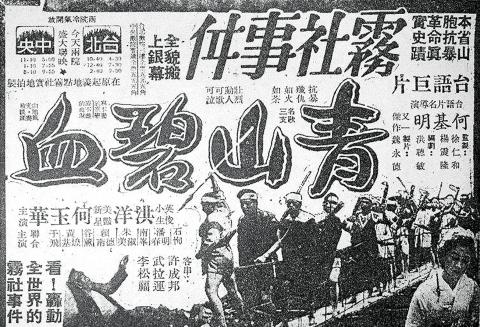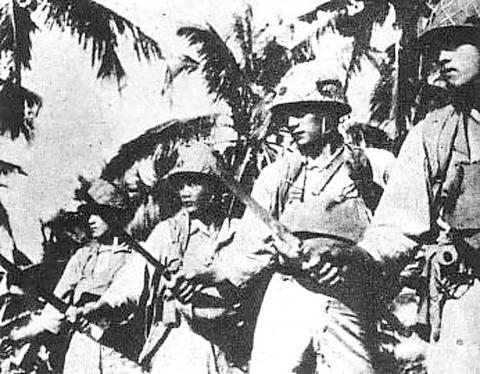OCT. 31 to NOV. 6
Almost a year had passed since the Wushe Incident (霧社事件), and the survivors of the Sediq tribe that rose up against Japanese rule had been forcefully relocated to Kawanakajima Village after taking another blow when rival Aborigines working with the Japanese attacked them in what is known as the “Second Wushe Incident.”
But the suffering just would not end. On Oct. 15, 1931, Japanese police invited the villagers to Puli under the guise of taking them on a trip to Sun Moon Lake as a reward for their hard work in setting up the village. Instead, they took the men to the precinct and arrested 23 of them who participated in the rebellion. They were never seen again.

Photo: Lin Liang-che, Taipei Times
This level of brutality makes it surprising to find that just a decade later, 23 Kawanakajima youth volunteered to fight for the Imperial Japanese Army during World War II. Only six made it back home.
Last week, Taiwan in Time looked at the direct and indirect causes that led up to the incident, where hundreds of Sediq warriors descended on an athletic meet at the local elementary school and killed 134 Japanese. The Japanese retaliated and quelled the rebellion in two months with about 600 Sediq dead.
This week, we look at the incident’s aftermath and the shift in Japanese colonial policy that led to these young Sediq being willing to die for the empire that mistreated and killed their people.

Photo courtesy of Wikimedia Commons
FROM SAVAGES TO SUBJECTS
Historian Leo Ching writes in the book Becoming Japanese: Colonial Taiwan and the Politics of Identity Formation that the colonial government was under fire after the Wushe Incident. The cause and resolution was “hotly debated in the Japanese Diet, and criticism of the colonial government was voiced both from within Japan and abroad,” Ching writes.
As a result, the government turned from exploitation and suppression to “incorporation and assimilation,” as the Japanese no longer saw the Aborigines as the “savage heathen waiting to be civilized through colonial benevolence, but were now imperialized subjects assimilated into the Japanese polity through the expressions of their loyalty to the Emperor.”

Photo courtesy of Wikimedia Commons
This does not mean oppressive policies and labor exploitation ceased, Ching adds, as it was simply a new directive. By 1935, the Aborigines were no longer called “savages,” but takasagozoku, with takasago being an archaic Japanese name for Taiwan and zoku referring to ethnicity.
Meanwhile, the Sediq decided not to talk about the Wushe Incident again after the fake trip incident for fear of further retribution. Dakis Pawan, who was born in Kawanakajima, writes in his book The Truth Behind the Sediq and the Wushe Incident (又見真相: 賽德克族與霧社事件) that whenever people of his father’s generation asked the elders anything about the incident, they would be reprimanded.
BECOMING JAPANESE
During the early days of Kawanakajima village, the Japanese closely monitored the Sediq, calling roll every morning and evening and banning all traditional activities as they sought to transform the tribe into a “modern and civilized” rice farming community. They organized the young people into working groups and taught them how to farm, sell their crops and speak Japanese.
It was not long before Kawanakajima was named an “exemplary Aboriginal community,” an “advanced tribe” that other Aboriginals should aspire toward. Dakis Pawan writes that many of these youth group members recall fondly the experience and held a high opinion toward Japan. They also frequently praised the “Japanese spirit.”
Dakis Pawan personally knew two former soldiers from his tribe who maintained that they were proud to fight for the emperor.
“It is evident that Japanese brainwashing had succeeded … and I never heard anything about them being forced to enlist,” he writes.
But was this “brainwashing” simply achieved by re-education? Ching writes that it is just part of the picture. “Positioned at the bottom of the colonial hierarchy and deprived of any political and economic possibilities, becoming ‘Japanese soldiers’ was perhaps the only avenue to perceived equality and agency.”
Waris Piho, a Sediq soldier, says he fought to “remove the disgrace that has been attached to the Wushe Incident. By enlisting, I would achieve the same honor as the Japanese.”
After the Nationalist takeover, the incident was lauded as a shining example of resistance against Japanese rule — but the fear of retribution remained in the hearts of tribal elders well into modern times. When Dakis Pawan started researching his tribe’s history in 1990 and spoke to a survivor about the incident, the old man shuddered and said, “Is it okay to talk about this now?”
Taiwan in Time, a column about Taiwan’s history that is published every Sunday, spotlights important or interesting events around the nation that have anniversaries this week.

Exceptions to the rule are sometimes revealing. For a brief few years, there was an emerging ideological split between the Democratic Progressive Party (DPP) and Chinese Nationalist Party (KMT) that appeared to be pushing the DPP in a direction that would be considered more liberal, and the KMT more conservative. In the previous column, “The KMT-DPP’s bureaucrat-led developmental state” (Dec. 11, page 12), we examined how Taiwan’s democratic system developed, and how both the two main parties largely accepted a similar consensus on how Taiwan should be run domestically and did not split along the left-right lines more familiar in

This month the government ordered a one-year block of Xiaohongshu (小紅書) or Rednote, a Chinese social media platform with more than 3 million users in Taiwan. The government pointed to widespread fraud activity on the platform, along with cybersecurity failures. Officials said that they had reached out to the company and asked it to change. However, they received no response. The pro-China parties, the Chinese Nationalist Party (KMT) and Taiwan People’s Party (TPP), immediately swung into action, denouncing the ban as an attack on free speech. This “free speech” claim was then echoed by the People’s Republic of China (PRC),

As I finally slid into the warm embrace of the hot, clifftop pool, it was a serene moment of reflection. The sound of the river reflected off the cave walls, the white of our camping lights reflected off the dark, shimmering surface of the water, and I reflected on how fortunate I was to be here. After all, the beautiful walk through narrow canyons that had brought us here had been inaccessible for five years — and will be again soon. The day had started at the Huisun Forest Area (惠蓀林場), at the end of Nantou County Route 80, north and east

Specialty sandwiches loaded with the contents of an entire charcuterie board, overflowing with sauces, creams and all manner of creative add-ons, is perhaps one of the biggest global food trends of this year. From London to New York, lines form down the block for mortadella, burrata, pistachio and more stuffed between slices of fresh sourdough, rye or focaccia. To try the trend in Taipei, Munchies Mafia is for sure the spot — could this be the best sandwich in town? Carlos from Spain and Sergio from Mexico opened this spot just seven months ago. The two met working in the